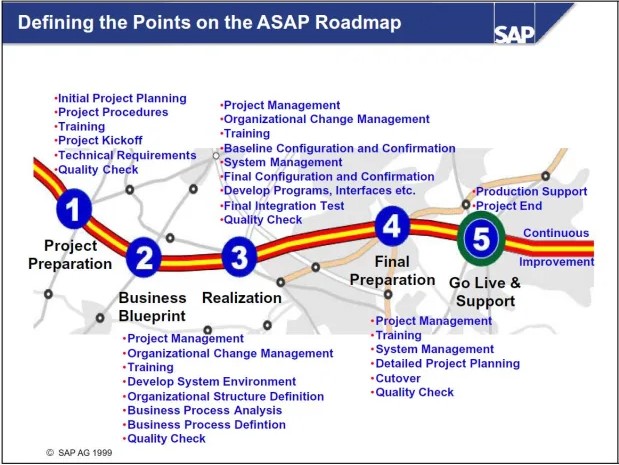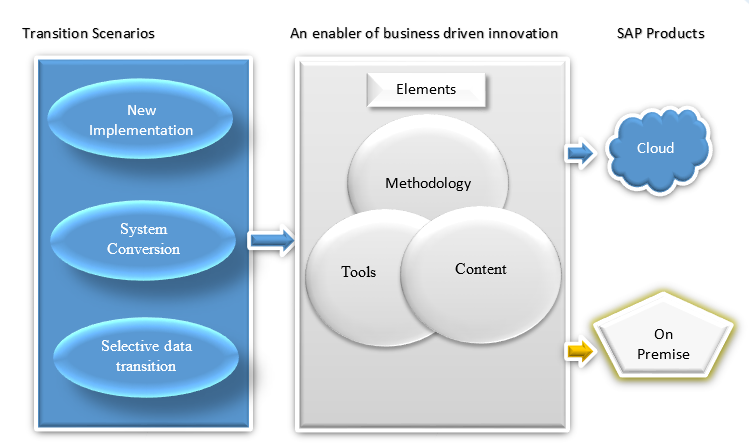SAP, short for Systems, Applications, and Products, is an influential player in the world of business software. Its solutions are used by businesses all over the world to enhance productivity, streamline operations, and increase efficiency. Whether you’re looking to implement SAP S4/HANA, SAP Ariba, or any other SAP solution, you’ll need a structured project management methodology to succeed.
In this article, we’ll dive into the world of SAP implementation methodologies, providing you with a comprehensive guide on how to navigate this complex process. We’ll explore the importance of team structure, discuss different SAP project management approaches, and provide an in-depth analysis of the SAP Activate methodology.

SAP Implementation: An Overview
SAP implementation is a term that refers to the systematic methodology employed by organisations to adopt SAP solutions. It’s a process that involves significant resources, including time, budget, and manpower, and if not done correctly, can lead to substantial operational disruptions.
The scope of an SAP implementation can vary significantly. Some organisations may choose to implement a comprehensive SAP ERP solution like SAP S/4HANA, while others may opt for a standalone solution like SAP Ariba. There’s also the possibility of implementing a single module within a solution, such as the SAP Ariba sourcing module.
Assembling your SAP Team
Implementing SAP is much like a game of chess – every move needs to be thoughtfully planned and executed. To ensure the success of your SAP implementation, you’ll need an experienced and dedicated team by your side.

The structure of your SAP team will depend on several factors, including the amount of time your internal team can dedicate to the project and their level of knowledge about ERP and SAP. If your company has limited ERP or SAP experience, it might be beneficial to seek external help. On the other hand, if your company is already well-versed with ERP or has experience with SAP ECC, a hybrid team approach that includes both internal and external members might be the best solution.
Regardless of your approach, there are a few roles that are absolutely necessary for any SAP project implementation:
SAP Project Manager: This is a pivotal role in your SAP project. Choose someone who is fully committed to the project and has previous experience implementing an ERP project.
SAP Solution Architect: This role is responsible for aligning your business processes with the SAP system. They are knowledgeable about integration-related topics and can help bridge departmental silos.
Business Experts: These are the people in your company who thoroughly understand your business processes but may not be familiar with SAP. They’ll provide the functional consultants with business process information.
Functional Consultants: These experts bridge the gap between the business process knowledge provided by the business experts and customise the system accordingly. They usually have specific domain knowledge in SAP.
Business Analysts: These individuals possess both business and system knowledge. They play an important role in moving project management activities forward, including unit acceptance testing (UAT), functional documentation review, and change management activities.
Trainers: They are responsible for providing end-user training.
Master data: These team members are in charge of migrating your data from your old system, cleaning it, and uploading it into the new system before your project’s go-live.
Change Management: This role is crucial for ensuring system adoption. They are in charge of bringing the end-user closer to the SAP S4/HANA implementation, bridging knowledge gaps, and assessing the system’s usability.

Types of SAP S/4HANA Implementations
Depending on the scale and scope of your migration, there are two primary categories of SAP S/4HANA implementation scenarios:
SAP Greenfield: Also known as a new implementation, this approach allows an organisation to completely redesign its processes and replace all existing methods with SAP solutions.
SAP Brownfield: This approach, also known as the system conversion approach, allows for SAP implementation without the need to completely redesign and disrupt existing processes. It’s a more gradual, step-by-step method towards comprehensive SAP implementation.
There’s also a third type of SAP implementation called selective data transition, where a company chooses to migrate only specific business functionalities.

SAP Implementation Methodologies
When it comes to SAP implementation, there are several methodologies to consider. Traditionally, SAP implementation was done through the Accelerated SAP (ASAP) procedure, which was designed and recommended by SAP based on standard project management methodology. The GlobalASAP methodology was also launched as a preconfigured system to facilitate SAP implementation for large global organisations.
Implementing SAP with ASAP and GlobalASAP Methodologies
The Accelerated SAP (ASAP) method simplifies the entire SAP implementation and documentation tasks into five well-defined steps: Project Preparation, Business Blueprint, Realisation, Final Preparation, and Rolling out, support, and maintenance.
On the other hand, the GlobalASAP approach was developed to facilitate multisite SAP implementation for large-scale companies. It identifies all activities that are not location-specific and maps them with a special structure known as the Global SAP Roadmap.

However, for cloud-based implementations, a more advanced methodology known as SAP Activate has emerged in recent years, boasting several advantages over ASAP.
SAP Activate: Cloud Implementation Models
SAP Activate aligns well with the Agile PMP approach to managing projects. It encourages continuous adjustments, fine-tuning, and improvements through short meetings (sprints) throughout the project development and implementation process.

Implementing SAP with SAP Activate
SAP Activate can be applied to all SAP implementation scenarios. The components, methodology, and best practices of SAP Activate include Agile methodology, ready-to-run scenarios, migration, and integration contents, and guided configuration.
SAP Activate Phases
Regardless of the minor differences, all SAP Activate methods consist of five phases: Prepare, Explore, Realise, Deploy, and Run.

SAP Implementation Partners
Given the complex nature of the implementation process, many large enterprises seek the help of professional SAP implementers known as SAP implementation partners. When choosing your ideal SAP implementation partner, it’s important to consider their expertise, cost, and how well their culture aligns with your organisation.
Final Thoughts
While SAP’s Activate or ASAP methodologies are not entirely new project management approaches, they are enriched with over fifty years of accumulated knowledge on how to best implement SAP systems. Activate relies on an agile approach, and ASAP relies on a waterfall approach. The choice is ultimately yours.


